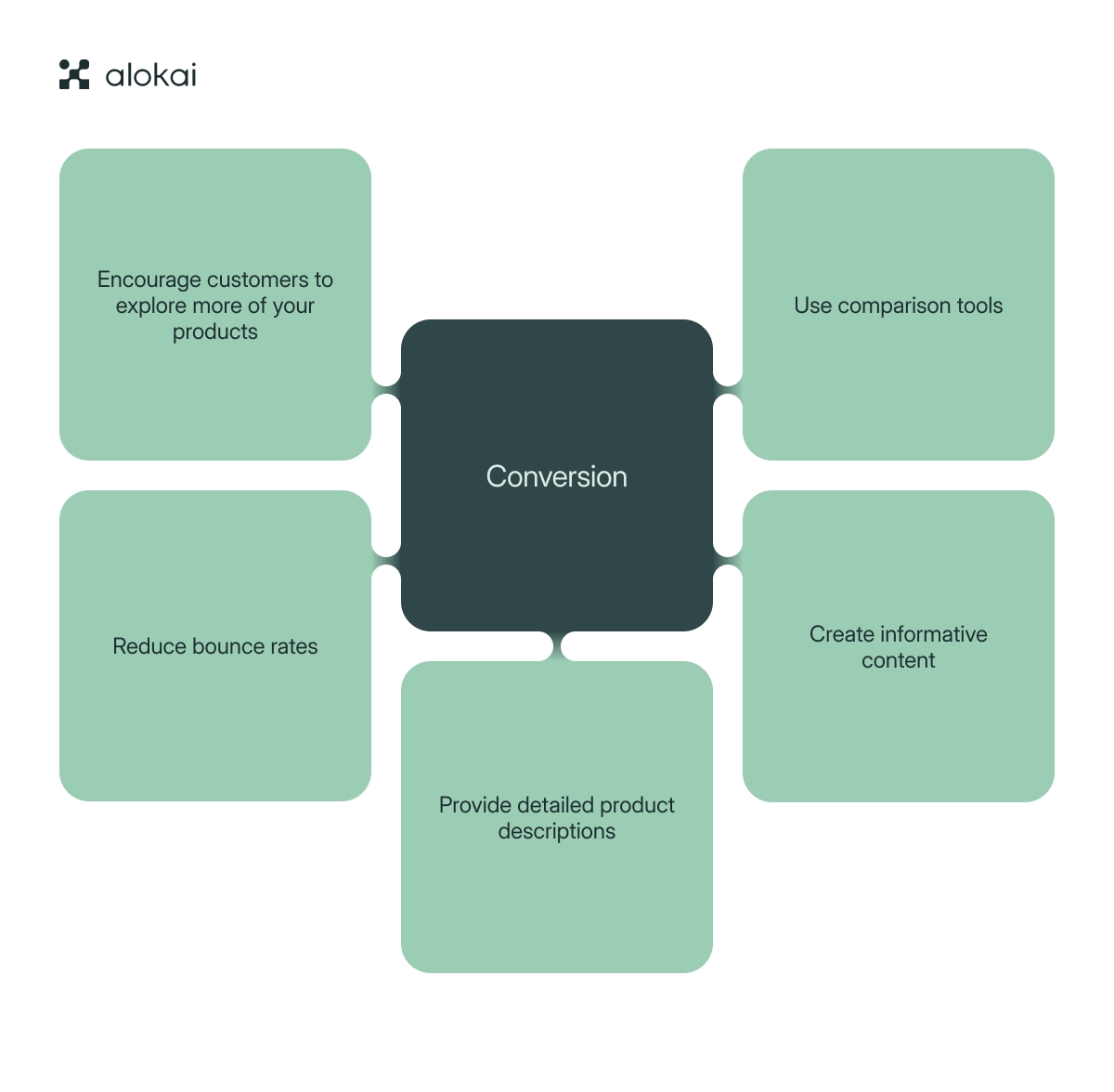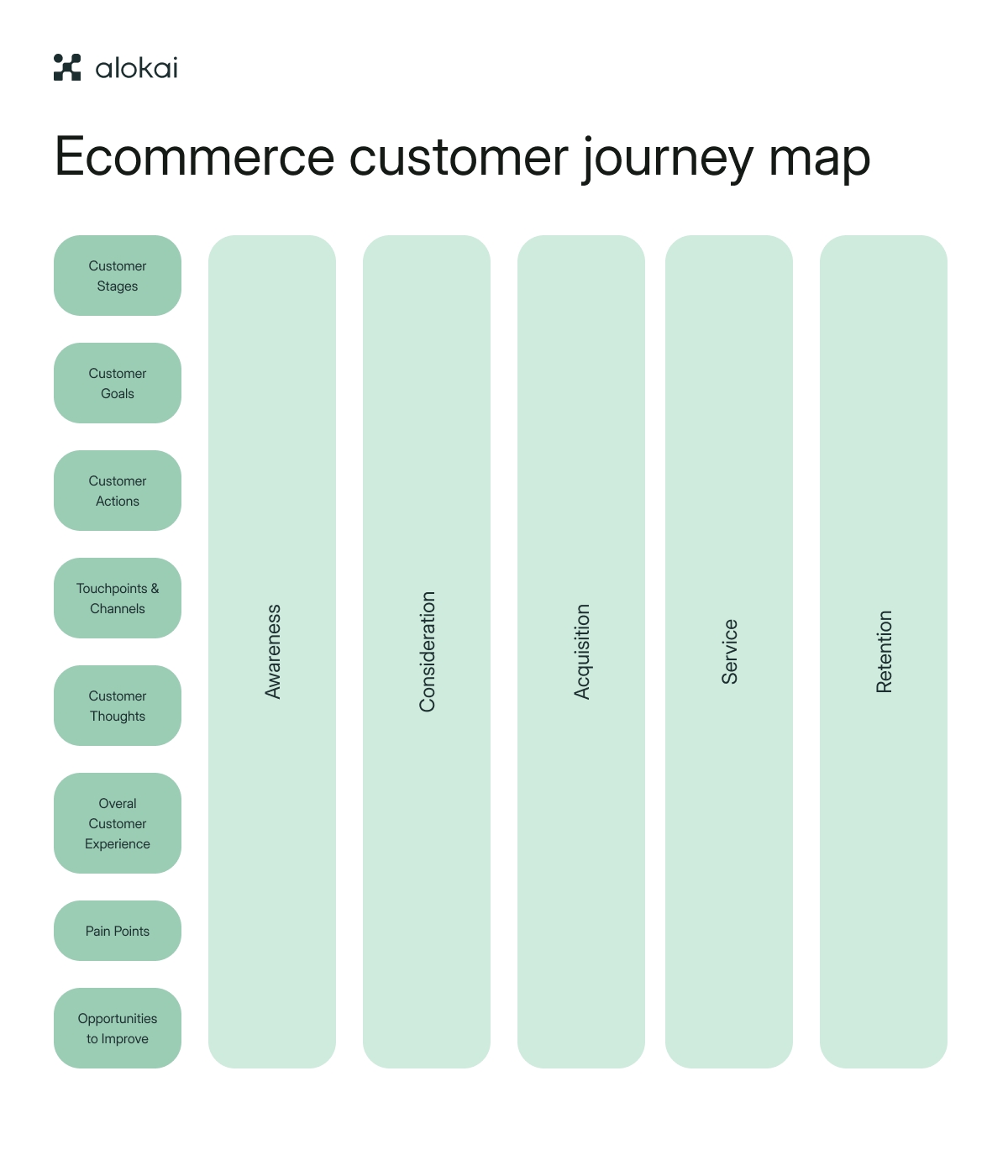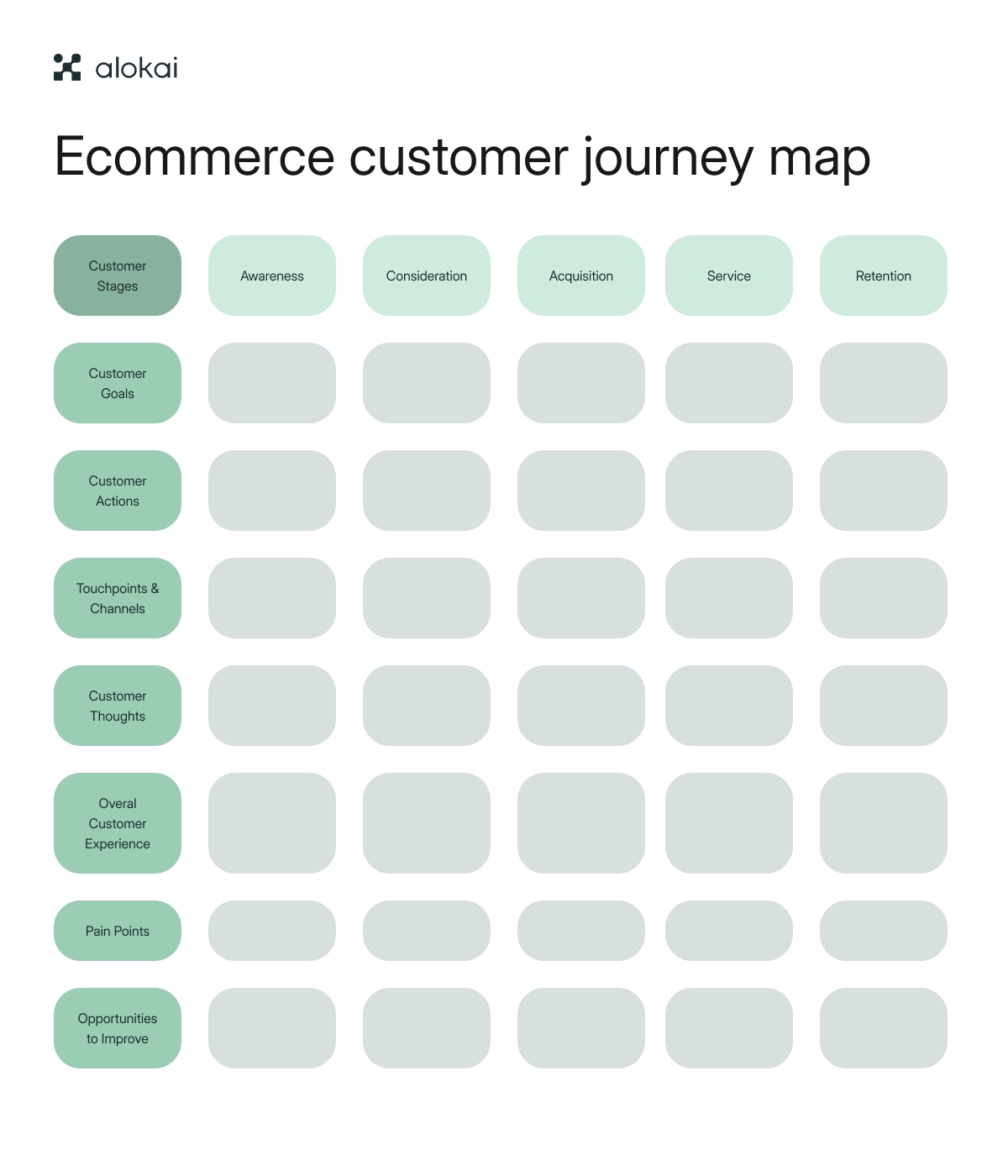The ecommerce customer journey encompasses every interaction a customer has with your online store, from discovering your brand to becoming a loyal advocate. Understanding this journey is crucial for optimizing your business—enhanced customer experiences lead to increased sales and greater loyalty. In this article, we’ll explore the key stages of the ecommerce customer journey and provide insights on optimizing each step for your business’s success.
Key Takeaways
- Understanding and mapping the ecommerce customer journey is vital for optimizing customer experiences, increasing sales, and fostering brand loyalty by visualizing stages such as awareness, consideration, conversion, retention, and advocacy.
- Personalization at every touchpoint, leveraging customer feedback, and adopting an omnichannel approach are key strategies to enhance the ecommerce customer experience and ensure a seamless and engaging shopping journey.
- Using analytics tools and key performance indicators (KPIs) like Customer Satisfaction Score (CSAT), Net Promoter Score (NPS), and Customer Lifetime Value (CLV), along with addressing common challenges like cart abandonment and improving the mobile experience, is crucial for tracking and improving the ecommerce customer journey.
Understanding the ecommerce customer journey
Understanding the ecommerce customer journey is crucial for optimizing customer experiences, increasing sales, and fostering brand loyalty. This journey involves recognizing the various stages your customers go through, from the moment they first discover your brand to becoming loyal advocates. Every interaction matters—be it the ease of your website navigation, the quality of information provided, or the effectiveness of your customer service.
Customers don’t just buy products; they buy into the entire experience encompassing your brand’s qualities, mission, values, and convenience. By mapping out each stage of the customer’s buying process, you can create a personalized experience, identify areas for improvement, and ultimately increase sales and loyalty. This visualization, known as a customer journey map, provides valuable insights into customer behavior, helping you understand where your customers come from, how long they stay at each stage, and what actions they take. It’s a powerful tool for ecommerce businesses aiming to enhance customer experience and retention.
What is the ecommerce customer journey?
The ecommerce customer journey includes every interaction with your ecommerce store, from the moment they first become aware of your brand to the point they make a purchase and beyond. It is often visualized through an ecommerce customer journey map, which breaks down the process into key stages:
- Awareness
- Consideration
- Conversion
- Retention
- Advocacy

Understanding this journey helps optimize each step, ensuring potential customers have a smooth path from discovery to loyalty. By analyzing and diagramming customers' steps, businesses can identify areas for improvement and create a more delightful, engaging experience that leads to higher conversion rates and deeper customer engagement.
Why is the ecommerce customer journey important?
Mapping and optimizing the ecommerce customer journey is vital for creating personalized experiences that meet customer needs and expectations. Businesses that invest in customer experience can see a significant increase in revenue—up to 70%—and 73% of customers confirm that their overall experience determines whether they make a purchase or abandon their cart. Focusing on the customer journey helps businesses provide a smooth and clear path, making it easier for customers to achieve their goals and ultimately increasing sales and loyalty.
Monitoring and enhancing the ecommerce customer journey adds more value to visitors, helping them achieve their goals more easily. By understanding each stage from the customer’s perspective, ecommerce businesses can identify pain points and areas for improvement, leading to a better overall customer experience. This focus on the customer journey is crucial for retaining existing customers and converting prospective ones into loyal advocates.
Key stages of the ecommerce customer journey
Each of these stages plays a vital role in shaping the overall customer experience and determining the success of your ecommerce business. Understanding and optimizing each stage allows you to create a seamless journey that guides potential customers from discovery to becoming loyal advocates.
Businesses usually focus on the three key customer journey stages:
- Awareness: Customers first discover your brand and products, often through search engines, social media, or word-of-mouth.
- Consideration: Customers evaluate their options and compare products, relying heavily on reviews and detailed product descriptions.
- Conversion: The moment of purchase, where strategies to reduce cart abandonment and streamline the checkout process are crucial.
The retention stage focuses on ensuring customer satisfaction and encouraging repeat purchases, while the advocacy stage involves loyal customers actively recommending your brand and sharing their positive experiences.
Awareness stage
Customers first discover your brand and products in the awareness stage, often through search engines, social media ads, or traditional media. This stage is crucial as it sets the foundation for the entire customer journey. It’s when potential customers become aware of a problem they must solve and seek relevant solutions.
Understanding where your customers come from and what brings them to your site is essential for optimizing your marketing and sales strategies. SEO plays a significant role in this stage, as it helps attract visitors through organic search results. Additionally, placing surveys on main traffic pages can provide valuable insights into what attracted visitors to your website and how they discovered your brand.
Consideration stage
Customers are interested in specific products or services in the consideration stage and evaluate their options. This stage is characterized by customers moving beyond general browsing and beginning to compare products, read reviews, and consider their options. It’s an opportunity for businesses to showcase their unique selling points and highlight customer reviews, ratings, and product photos to help customers make informed decisions.
During this stage, it’s important to:
- Reduce bounce rates
- Encourage customers to explore more of your products
- Provide detailed product descriptions
- Use comparison tools
- Create informative content

These strategies can help guide customers through their decision-making process. By understanding customer behavior at this stage, businesses can tailor their strategies to meet customer needs and preferences, ultimately leading to higher conversion rates.
Conversion stage
The conversion stage is the moment of purchase, where all previous efforts culminate in a sale. This stage is crucial as it marks the point at which a prospective customer becomes an actual customer, contributing to your conversion rate. Success at this stage involves not only securing the initial purchase but also creating a positive customer experience that may lead to repeat purchases.
Strategies to reduce cart abandonment and streamline the checkout process are essential in this stage. Providing easy payment and delivery options, ensuring website security, and offering incentives in calls-to-action (CTAs) can help drive faster responses from potential buyers and minimize friction in the buying process. By focusing on minimizing obstacles and enhancing user experience, businesses can improve their conversion rates and overall customer satisfaction.
Retention stage
The retention stage is all about keeping customers satisfied and encouraging them to return for future purchases. Customer retention is crucial for maximizing ROI and increasing profits, as it costs less to retain existing customers than to acquire new ones. Metrics like Customer Retention Rate (CRR) and Repeat Purchase Rate (RPR) are essential for measuring the success of retention efforts.
Ensuring customers have a positive experience with your brand is essential for fostering loyalty. Strategies to consider include:
- Personalized emails
- Loyalty programs
- Special offers
- Proactive customer support
- Responding to customer queries and feedback
Implementing these strategies can help keep customers engaged and coming back for more, leading to better retention rates and increased customer satisfaction.
Advocacy stage
The advocacy stage is when your best customers become brand advocates, actively recommending your products, sharing their positive experiences, and leaving reviews. This stage is significant as loyal customers’ recommendations can significantly impact your revenue and brand reputation.
Encouraging customer advocacy involves incentivizing customers to leave reviews and share their experiences on social media. Creating shareable content and providing excellent customer service can encourage customers to advocate for your brand. By fostering a community of loyal customers, businesses can benefit from word-of-mouth marketing and increased brand visibility.
Mapping the ecommerce customer journey

Mapping the ecommerce customer journey involves defining your buyer personas, identifying customer touchpoints, and creating a journey map to visualize and improve customer interactions. This process helps businesses understand the customer journey's various stages and identify areas for improvement.
The first step in mapping the customer journey is to define your buyer personas. Understanding your ideal customers’ experience, needs, and preferences is crucial for crafting tailored journeys. Next, identify all the touchpoints where customers interact with your brand, from initial awareness to post-purchase. Finally, a customer journey map will be created to visualize customers' steps and plan improvements for each touchpoint.
Define your buyer personas.
Defining buyer personas is essential for understanding your ideal customers and tailoring the customer journey accordingly. Buyer personas are detailed profiles of your target customers, including demographics, behaviors, and preferences. These personas help businesses understand the customer experience from the customer’s perspective, allowing for more effective personalization and engagement.
Segmentation criteria such as demographics, purchase history, customer value, and geographical location can be used to create detailed personas. The PIE framework—Potential, Importance, Ease—can help prioritize customer segments for personalization. By defining your buyer personas, you can ensure that your marketing efforts and customer journey map align with your target customers' needs and preferences.
Identify customer touchpoints
Identifying customer touchpoints is crucial for determining engagement strategies and addressing pain points in the customer journey. Touchpoints are any points at which customers interact with your brand, whether online or offline. Understanding these touchpoints helps businesses optimize interactions to enhance the overall customer experience.
Data from customer feedback, surveys, and analytics is essential for understanding experiences at each touchpoint. Businesses can identify areas needing improvement and optimize touchpoints for maximum engagement by measuring customer response to each touchpoint and tracking customer interaction.
Creating touchpoints at every stage of the customer journey helps ensure that each interaction serves its purpose and enhances the overall experience.
Create a customer journey map.
Creating a customer journey map helps visualize the customer experience and plan improvements for each touchpoint. A customer journey map visually represents the steps customers go through when interacting with your brand. Using a customer journey map template simplifies complex information and makes it easy to understand the customer journey from start to finish. Incorporating customer journey maps into your strategy can further enhance your understanding of the overall customer experience.
To create a practical customer journey map, follow these steps:
- Start by plotting touchpoints and data on a timeline, reflecting fundamental user interactions through usability testing and product analytic tools.
- Identify pain points and opportunities in the journey map to highlight areas for improvement.
- Clear objectives are crucial to guide data collection and ensure the accuracy and relevancy of the journey map.
By mapping the customer journey, businesses can gain valuable insights into customer behavior and optimize the overall experience, including various customer journeys.

Enhancing the ecommerce customer experience
Enhancing the ecommerce customer experience involves personalization at every touchpoint, leveraging customer feedback, and adopting an omnichannel approach. Improving customer experience is vital for boosting satisfaction, loyalty, and overall sales. Businesses can create a more engaging and seamless customer shopping experience by focusing on these critical areas.
Personalization is a powerful tool for increasing sales and customer retention. Leveraging customer feedback helps businesses understand satisfaction levels and identify areas for improvement. Adopting an omnichannel approach ensures a consistent brand experience across all channels and platforms, enhancing the customer journey.
Personalization at every touchpoint
Personalization at every touchpoint helps create tailored customer experiences, increasing satisfaction and loyalty. Integrating customer data from various channels allows businesses to deliver a seamless and personalized shopping experience. Some ways to achieve this include:
- Customizing content based on buying preferences, location, age, and gender
- Sending customized recommendations and offers based on past purchases
- Providing customized product recommendations on the website
- Using customized email marketing campaigns
- Offering personalized customer service and support
By implementing these strategies, businesses can offer a personalized approach that meets their customers' unique needs and preferences.
Brands can enhance engagement by:
- Displaying personalized content and offers to different visitors based on their previous interactions
- Implementing customer segmentation, which involves dividing customers into groups based on common characteristics
- Delivering individualized interactions, product recommendations, and services based on unique customer preferences and behaviors
By implementing these strategies, businesses can optimize the overall customer journey.
Leveraging customer feedback
Leveraging customer feedback helps businesses understand customer satisfaction and areas for improvement. Some ways to collect feedback include:
- On-page surveys, especially during the checkout process, to identify elements causing customers to abandon their carts
- Surveys to uncover insights that other data collection methods might miss
- A deeper understanding of customer behavior and preferences
Collecting feedback through these methods can provide valuable information for businesses.
Analyzing feedback allows businesses to make data-driven decisions to enhance the customer journey. Asking customers for feedback on improving their shopping experience can help identify and rectify pain points. By regularly gathering and analyzing customer feedback, businesses can:
- Continuously improve their products and services
- Identify trends and patterns in customer preferences
- Address any issues or concerns promptly
- Enhance the overall customer experience
Omnichannel approach
An omnichannel approach ensures a seamless and consistent customer experience across all channels and platforms. Ready-made buyers often require multiple touchpoints across various channels before making a purchase. An omnichannel strategy ensures that customers receive a consistent brand experience, whether interacting with your brand on mobile, desktop, or physical stores.
Employing ads retargeting and social media posts keeps products visible to previous buyers, maintaining a consistent presence. Frontend as a Service (FEaaS) can improve the ecommerce customer experience by providing a fast and mobile-optimized frontend, allowing quicker creation, testing, and deployment of features. By embracing an omnichannel approach, businesses can enhance the customer journey and keep customers engaged across all platforms.
Tools and metrics for measuring ecommerce customer journey success
Measuring the success of the ecommerce customer journey involves tracking key performance indicators (KPIs) and using analytics tools. These metrics provide valuable insights into customer behavior and help businesses optimize their strategies for better results. By monitoring these metrics, companies can identify areas for improvement and make data-driven decisions to enhance the customer journey.
Key performance indicators such as Customer Satisfaction Score (CSAT), Net Promoter Score (NPS), and Customer Lifetime Value (CLV) are essential for understanding and optimizing the ecommerce customer journey. Analytics tools like Google Analytics and Heatmaps offer detailed insights into user interactions and website performance, helping businesses identify pain points and opportunities for improvement.
Key performance indicators (KPIs)
Key performance indicators (KPIs) are essential for tracking the success of the ecommerce customer journey. The Customer Satisfaction Score (CSAT) gauges customer happiness with products or services and is commonly collected through surveys. The Net Promoter Score (NPS) measures customer loyalty by gauging how likely customers are to recommend your brand to others, indicating customer satisfaction and potential advocacy.
Customer Lifetime Value (CLV) is a metric that calculates the total revenue a customer generates for a business throughout their relationship with the brand. It helps companies to understand the value of their customer base over time. It is significant for tracking the overall value of a customer and helps guide strategies to maximize long-term profitability. By monitoring these KPIs, businesses can gain valuable insights into customer behavior and make informed decisions to enhance the customer journey.
Analytics tools
Analytics tools are invaluable for gaining insights into the ecommerce customer journey. Google Analytics tracks metrics such as unique pageviews, bounce rates, and user session durations. It can create a funnel or path exploration reports to examine different segments of users, helping businesses understand where customers drop off or fail to convert.
Heatmaps can be used to:
- Visually represent user interactions on a webpage by highlighting areas with the most clicks and activity
- Understand and improve user interactions, for example, by revealing how mobile users interact with navigation options
- Optimize the customer journey and enhance the overall customer experience
Businesses can gain valuable insights and make data-driven decisions using these analytics tools.
Common challenges and solutions in the ecommerce customer journey
The ecommerce customer journey is not without its challenges. Common issues include cart abandonment, poor mobile experience, and handling negative feedback. These challenges can significantly impact customer satisfaction and conversion rates, but businesses can overcome them with the right strategies.
Addressing these challenges involves understanding customer behavior, optimizing touchpoints, and continuously improving the customer experience. By identifying and addressing pain points, businesses can create a smoother and more enjoyable customer journey, leading to higher satisfaction and loyalty.
Reducing cart abandonment
Reducing cart abandonment is crucial for improving conversion rates. The cart abandonment rate tracks the percentage of visitors who add items to their cart but leave without completing the purchase. One effective technique to reduce cart abandonment is implementing retargeting ads to remind customers of their abandoned carts.
Simplifying the checkout process can significantly minimize cart abandonment rates. Some strategies to consider include:
- Streamlining the number of steps required to complete a purchase
- Offering guest checkout options
- Providing clear and concise instructions throughout the process
- Optimizing the checkout page for mobile devices
Additionally, offering financing options can help reduce cart abandonment by addressing customers’ concerns about affordability. By focusing on these strategies, businesses can improve the conversion stage of the customer journey and increase overall sales.
Improving mobile experience
Improving the mobile experience is essential for offering an excellent experience to potential customers, as around half of all internet traffic originates from mobile devices. Optimizing the ecommerce site for mobile users enhances accessibility and user experience.
Mobile responsiveness is critical to ensure users' seamless shopping experience across devices. Mobile website optimization should focus on making key elements easily clickable and visible to enhance user experience. Businesses can improve the overall customer journey by prioritizing mobile optimization and keeping customers engaged.
Handling negative feedback
Handling negative feedback effectively is crucial in turning dissatisfied customers into loyal ones. Responding promptly and professionally to negative reviews can turn dissatisfied customers into loyal ones. Learning from negative feedback can help ecommerce businesses improve their products and services.
By addressing customer concerns and making improvements based on feedback, businesses can enhance the overall customer journey and foster a positive brand reputation. Encouraging positive reviews and maintaining open customer communication can improve customer satisfaction and loyalty.
Summary
Understanding and optimizing the ecommerce customer journey is crucial for creating a seamless and personalized customer experience. Businesses can increase customer satisfaction, loyalty, and sales by mapping the customer journey, defining buyer personas, identifying touchpoints, and enhancing the overall experience. Addressing common challenges and leveraging the right tools and metrics can improve the customer journey, leading to long-term success. Embrace these strategies to elevate your ecommerce business and ensure a delightful customer journey from start to finish.
